Analysis of Australian Coal Mining Industry and International Trade
VerifiedAdded on 2021/05/31
|17
|3813
|53
Report
AI Summary
This report provides a comprehensive analysis of the Australian coal mining industry and its implications for international trade and the national economy. It begins with an introduction to the Australian economy, highlighting its shift from a mining-based to a service-sector-based economy, and emphasizes the significance of the coal mining sector. The report then delves into the current condition of the Australian coal mining industry, discussing production and export trends. A supply and demand framework is used to analyze the dynamics of the Australian mining industry. The report further examines the impacts of changes in coal mining on the Australian economy, focusing on macroeconomic indicators such as Gross Domestic Product (GDP), employment rates, inflation, and the trade balance. The report concludes with a summary of findings and recommendations.

Running head: ECONOMICS AND INTERNATIONAL TRADE
Economics and international trade
Name of the student:
Name of the University:
Author note
Economics and international trade
Name of the student:
Name of the University:
Author note
Paraphrase This Document
Need a fresh take? Get an instant paraphrase of this document with our AI Paraphraser
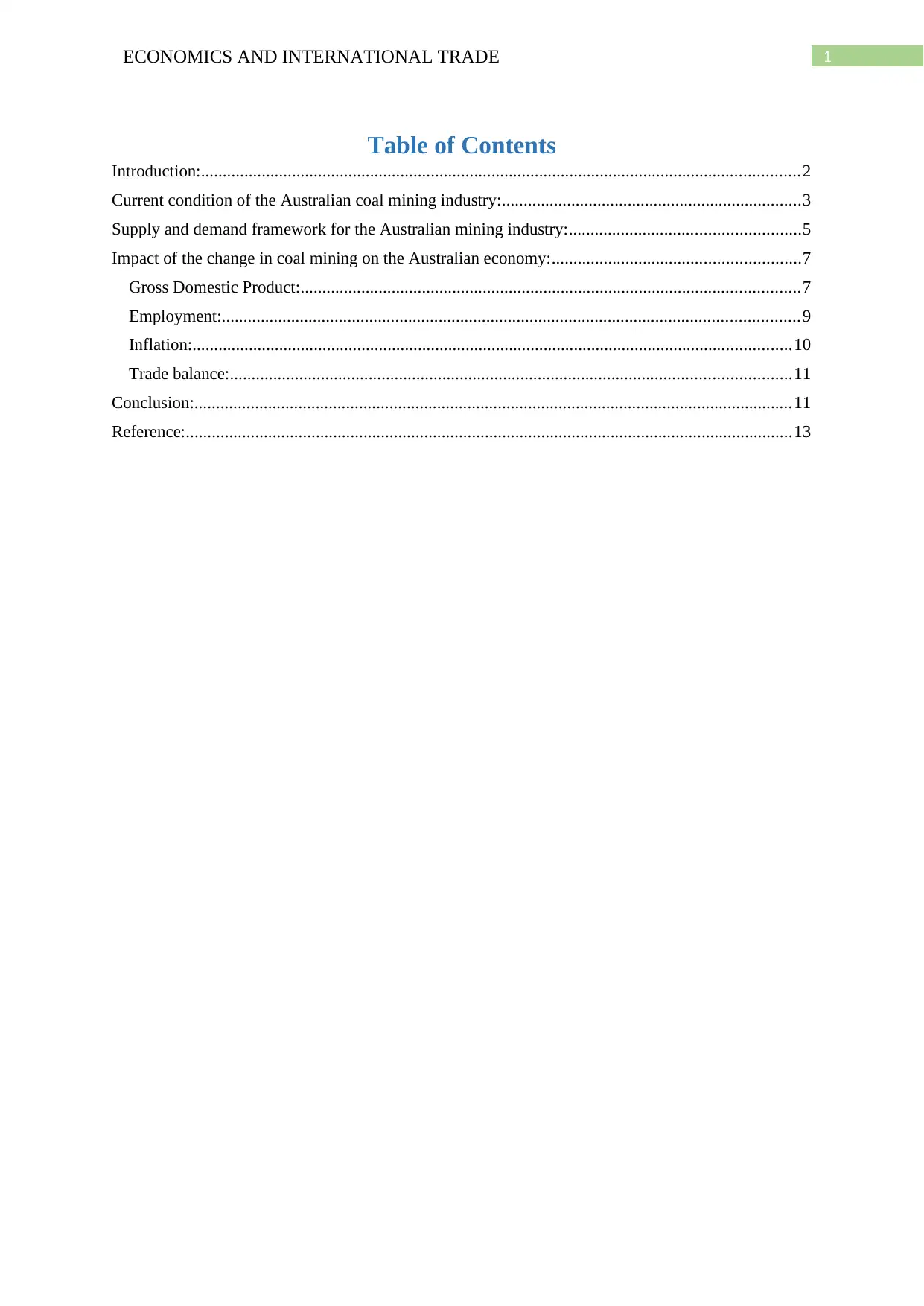
1ECONOMICS AND INTERNATIONAL TRADE
Table of Contents
Introduction:..........................................................................................................................................2
Current condition of the Australian coal mining industry:.....................................................................3
Supply and demand framework for the Australian mining industry:.....................................................5
Impact of the change in coal mining on the Australian economy:.........................................................7
Gross Domestic Product:...................................................................................................................7
Employment:.....................................................................................................................................9
Inflation:..........................................................................................................................................10
Trade balance:.................................................................................................................................11
Conclusion:..........................................................................................................................................11
Reference:............................................................................................................................................13
Table of Contents
Introduction:..........................................................................................................................................2
Current condition of the Australian coal mining industry:.....................................................................3
Supply and demand framework for the Australian mining industry:.....................................................5
Impact of the change in coal mining on the Australian economy:.........................................................7
Gross Domestic Product:...................................................................................................................7
Employment:.....................................................................................................................................9
Inflation:..........................................................................................................................................10
Trade balance:.................................................................................................................................11
Conclusion:..........................................................................................................................................11
Reference:............................................................................................................................................13
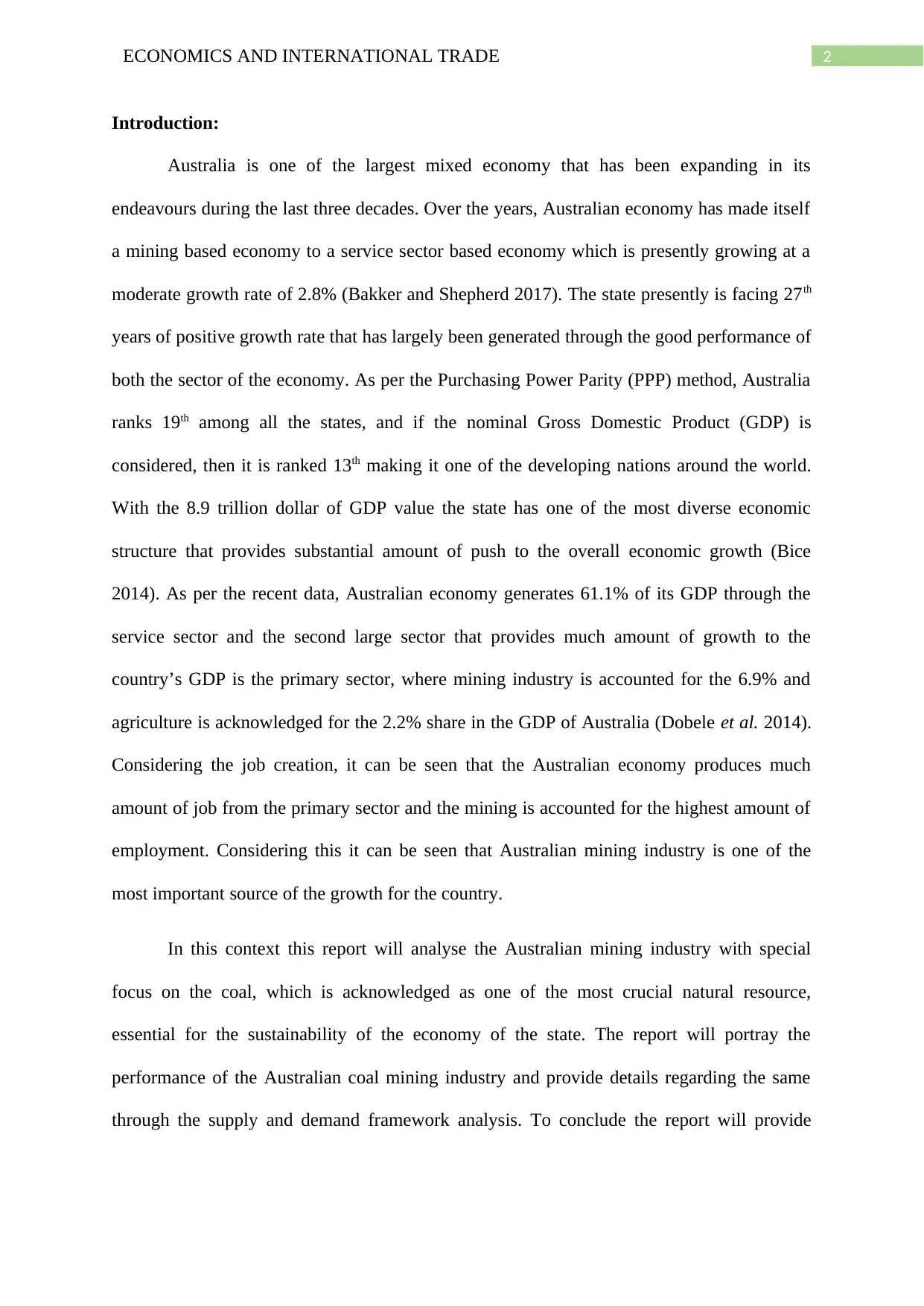
2ECONOMICS AND INTERNATIONAL TRADE
Introduction:
Australia is one of the largest mixed economy that has been expanding in its
endeavours during the last three decades. Over the years, Australian economy has made itself
a mining based economy to a service sector based economy which is presently growing at a
moderate growth rate of 2.8% (Bakker and Shepherd 2017). The state presently is facing 27th
years of positive growth rate that has largely been generated through the good performance of
both the sector of the economy. As per the Purchasing Power Parity (PPP) method, Australia
ranks 19th among all the states, and if the nominal Gross Domestic Product (GDP) is
considered, then it is ranked 13th making it one of the developing nations around the world.
With the 8.9 trillion dollar of GDP value the state has one of the most diverse economic
structure that provides substantial amount of push to the overall economic growth (Bice
2014). As per the recent data, Australian economy generates 61.1% of its GDP through the
service sector and the second large sector that provides much amount of growth to the
country’s GDP is the primary sector, where mining industry is accounted for the 6.9% and
agriculture is acknowledged for the 2.2% share in the GDP of Australia (Dobele et al. 2014).
Considering the job creation, it can be seen that the Australian economy produces much
amount of job from the primary sector and the mining is accounted for the highest amount of
employment. Considering this it can be seen that Australian mining industry is one of the
most important source of the growth for the country.
In this context this report will analyse the Australian mining industry with special
focus on the coal, which is acknowledged as one of the most crucial natural resource,
essential for the sustainability of the economy of the state. The report will portray the
performance of the Australian coal mining industry and provide details regarding the same
through the supply and demand framework analysis. To conclude the report will provide
Introduction:
Australia is one of the largest mixed economy that has been expanding in its
endeavours during the last three decades. Over the years, Australian economy has made itself
a mining based economy to a service sector based economy which is presently growing at a
moderate growth rate of 2.8% (Bakker and Shepherd 2017). The state presently is facing 27th
years of positive growth rate that has largely been generated through the good performance of
both the sector of the economy. As per the Purchasing Power Parity (PPP) method, Australia
ranks 19th among all the states, and if the nominal Gross Domestic Product (GDP) is
considered, then it is ranked 13th making it one of the developing nations around the world.
With the 8.9 trillion dollar of GDP value the state has one of the most diverse economic
structure that provides substantial amount of push to the overall economic growth (Bice
2014). As per the recent data, Australian economy generates 61.1% of its GDP through the
service sector and the second large sector that provides much amount of growth to the
country’s GDP is the primary sector, where mining industry is accounted for the 6.9% and
agriculture is acknowledged for the 2.2% share in the GDP of Australia (Dobele et al. 2014).
Considering the job creation, it can be seen that the Australian economy produces much
amount of job from the primary sector and the mining is accounted for the highest amount of
employment. Considering this it can be seen that Australian mining industry is one of the
most important source of the growth for the country.
In this context this report will analyse the Australian mining industry with special
focus on the coal, which is acknowledged as one of the most crucial natural resource,
essential for the sustainability of the economy of the state. The report will portray the
performance of the Australian coal mining industry and provide details regarding the same
through the supply and demand framework analysis. To conclude the report will provide
⊘ This is a preview!⊘
Do you want full access?
Subscribe today to unlock all pages.

Trusted by 1+ million students worldwide
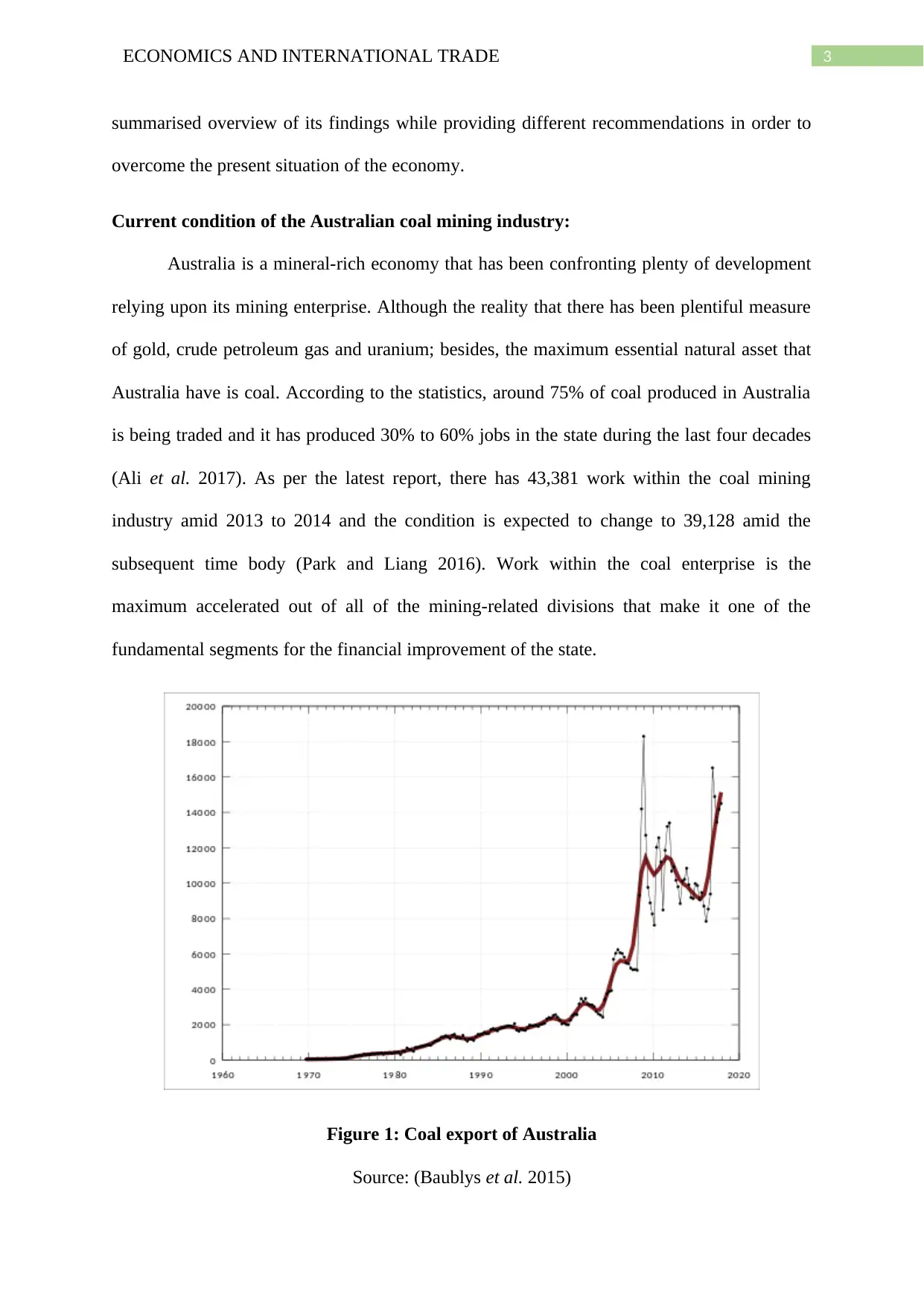
3ECONOMICS AND INTERNATIONAL TRADE
summarised overview of its findings while providing different recommendations in order to
overcome the present situation of the economy.
Current condition of the Australian coal mining industry:
Australia is a mineral-rich economy that has been confronting plenty of development
relying upon its mining enterprise. Although the reality that there has been plentiful measure
of gold, crude petroleum gas and uranium; besides, the maximum essential natural asset that
Australia have is coal. According to the statistics, around 75% of coal produced in Australia
is being traded and it has produced 30% to 60% jobs in the state during the last four decades
(Ali et al. 2017). As per the latest report, there has 43,381 work within the coal mining
industry amid 2013 to 2014 and the condition is expected to change to 39,128 amid the
subsequent time body (Park and Liang 2016). Work within the coal enterprise is the
maximum accelerated out of all of the mining-related divisions that make it one of the
fundamental segments for the financial improvement of the state.
Figure 1: Coal export of Australia
Source: (Baublys et al. 2015)
summarised overview of its findings while providing different recommendations in order to
overcome the present situation of the economy.
Current condition of the Australian coal mining industry:
Australia is a mineral-rich economy that has been confronting plenty of development
relying upon its mining enterprise. Although the reality that there has been plentiful measure
of gold, crude petroleum gas and uranium; besides, the maximum essential natural asset that
Australia have is coal. According to the statistics, around 75% of coal produced in Australia
is being traded and it has produced 30% to 60% jobs in the state during the last four decades
(Ali et al. 2017). As per the latest report, there has 43,381 work within the coal mining
industry amid 2013 to 2014 and the condition is expected to change to 39,128 amid the
subsequent time body (Park and Liang 2016). Work within the coal enterprise is the
maximum accelerated out of all of the mining-related divisions that make it one of the
fundamental segments for the financial improvement of the state.
Figure 1: Coal export of Australia
Source: (Baublys et al. 2015)
Paraphrase This Document
Need a fresh take? Get an instant paraphrase of this document with our AI Paraphraser
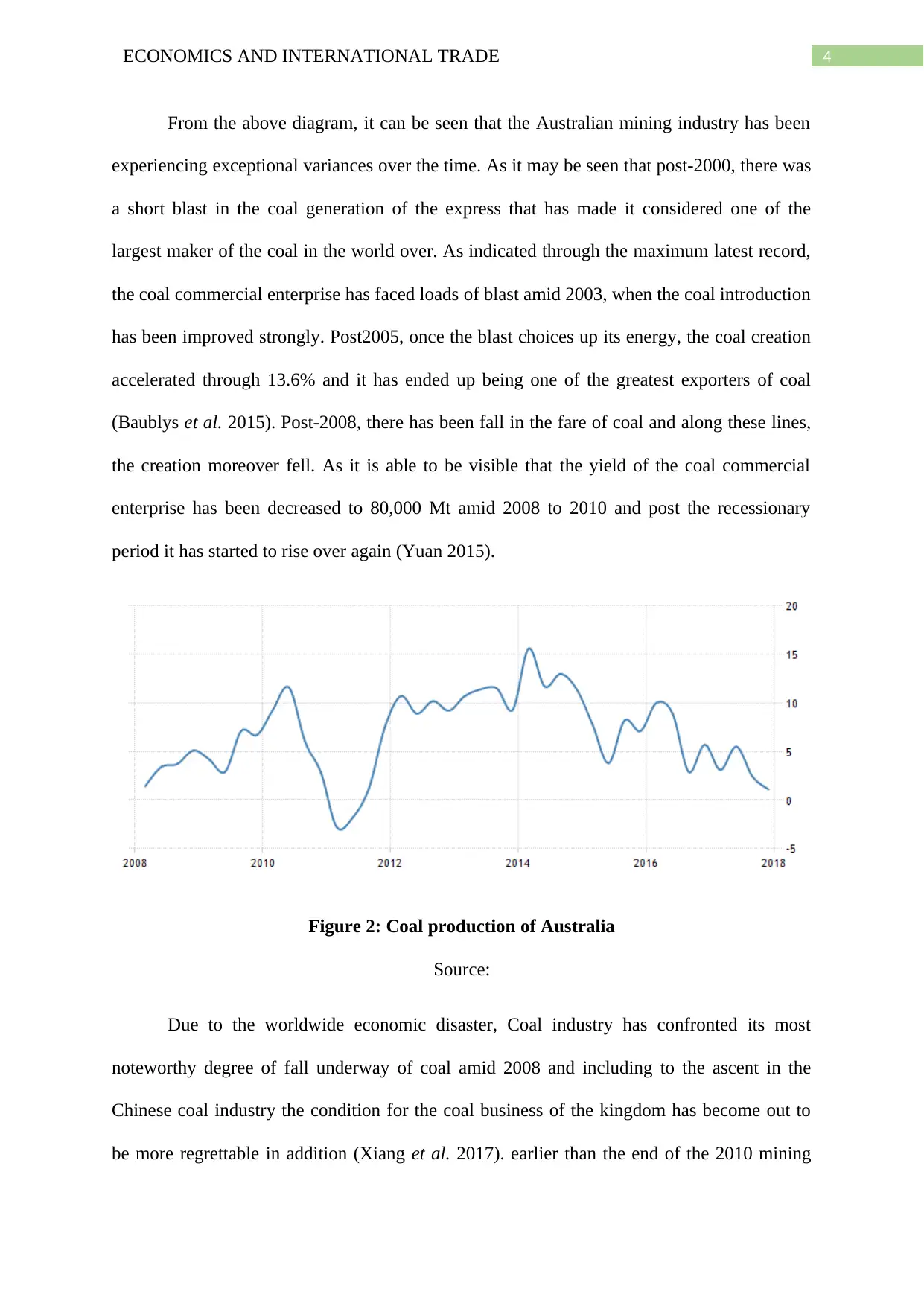
4ECONOMICS AND INTERNATIONAL TRADE
From the above diagram, it can be seen that the Australian mining industry has been
experiencing exceptional variances over the time. As it may be seen that post-2000, there was
a short blast in the coal generation of the express that has made it considered one of the
largest maker of the coal in the world over. As indicated through the maximum latest record,
the coal commercial enterprise has faced loads of blast amid 2003, when the coal introduction
has been improved strongly. Post2005, once the blast choices up its energy, the coal creation
accelerated through 13.6% and it has ended up being one of the greatest exporters of coal
(Baublys et al. 2015). Post-2008, there has been fall in the fare of coal and along these lines,
the creation moreover fell. As it is able to be visible that the yield of the coal commercial
enterprise has been decreased to 80,000 Mt amid 2008 to 2010 and post the recessionary
period it has started to rise over again (Yuan 2015).
Figure 2: Coal production of Australia
Source:
Due to the worldwide economic disaster, Coal industry has confronted its most
noteworthy degree of fall underway of coal amid 2008 and including to the ascent in the
Chinese coal industry the condition for the coal business of the kingdom has become out to
be more regrettable in addition (Xiang et al. 2017). earlier than the end of the 2010 mining
From the above diagram, it can be seen that the Australian mining industry has been
experiencing exceptional variances over the time. As it may be seen that post-2000, there was
a short blast in the coal generation of the express that has made it considered one of the
largest maker of the coal in the world over. As indicated through the maximum latest record,
the coal commercial enterprise has faced loads of blast amid 2003, when the coal introduction
has been improved strongly. Post2005, once the blast choices up its energy, the coal creation
accelerated through 13.6% and it has ended up being one of the greatest exporters of coal
(Baublys et al. 2015). Post-2008, there has been fall in the fare of coal and along these lines,
the creation moreover fell. As it is able to be visible that the yield of the coal commercial
enterprise has been decreased to 80,000 Mt amid 2008 to 2010 and post the recessionary
period it has started to rise over again (Yuan 2015).
Figure 2: Coal production of Australia
Source:
Due to the worldwide economic disaster, Coal industry has confronted its most
noteworthy degree of fall underway of coal amid 2008 and including to the ascent in the
Chinese coal industry the condition for the coal business of the kingdom has become out to
be more regrettable in addition (Xiang et al. 2017). earlier than the end of the 2010 mining
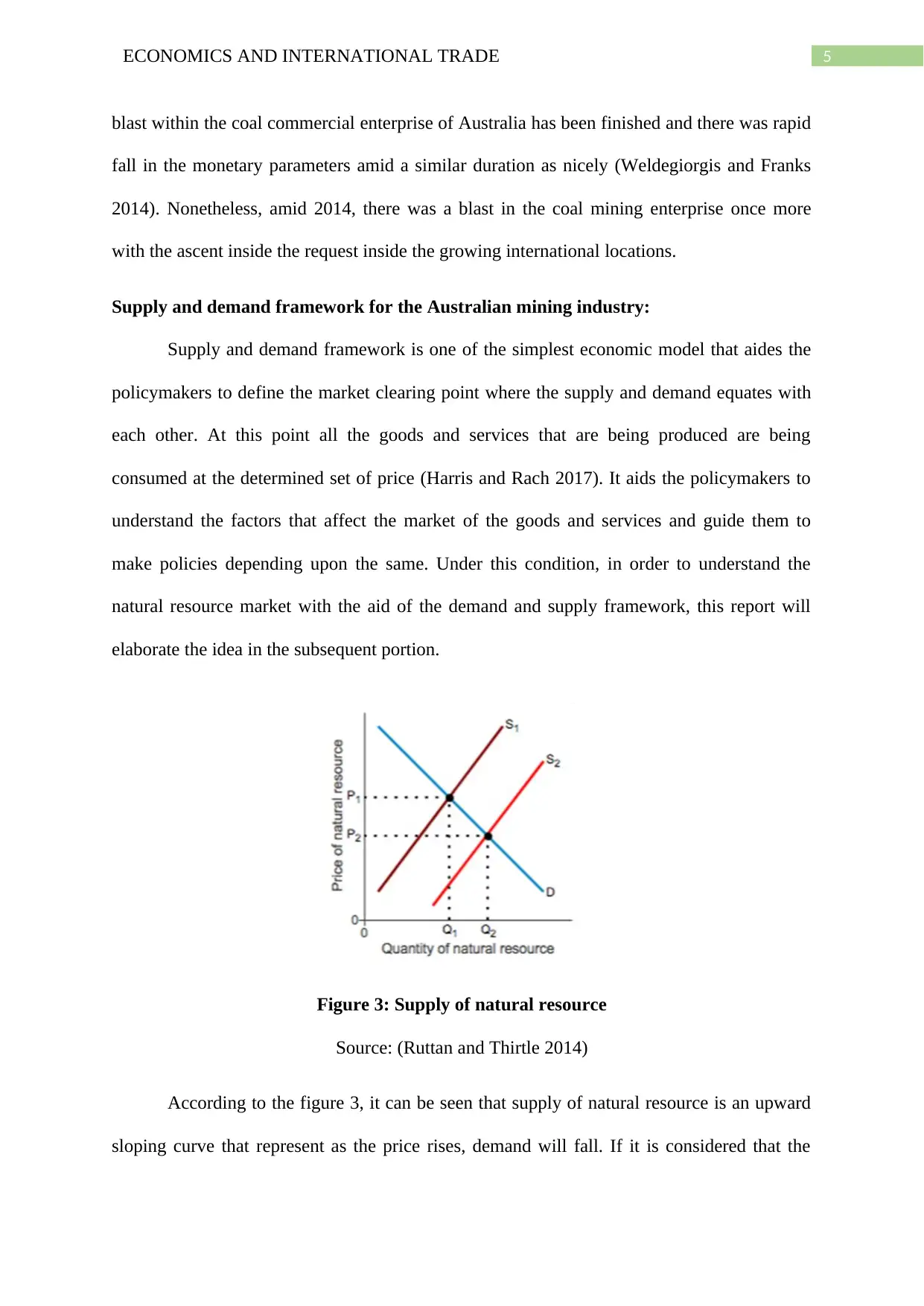
5ECONOMICS AND INTERNATIONAL TRADE
blast within the coal commercial enterprise of Australia has been finished and there was rapid
fall in the monetary parameters amid a similar duration as nicely (Weldegiorgis and Franks
2014). Nonetheless, amid 2014, there was a blast in the coal mining enterprise once more
with the ascent inside the request inside the growing international locations.
Supply and demand framework for the Australian mining industry:
Supply and demand framework is one of the simplest economic model that aides the
policymakers to define the market clearing point where the supply and demand equates with
each other. At this point all the goods and services that are being produced are being
consumed at the determined set of price (Harris and Rach 2017). It aids the policymakers to
understand the factors that affect the market of the goods and services and guide them to
make policies depending upon the same. Under this condition, in order to understand the
natural resource market with the aid of the demand and supply framework, this report will
elaborate the idea in the subsequent portion.
Figure 3: Supply of natural resource
Source: (Ruttan and Thirtle 2014)
According to the figure 3, it can be seen that supply of natural resource is an upward
sloping curve that represent as the price rises, demand will fall. If it is considered that the
blast within the coal commercial enterprise of Australia has been finished and there was rapid
fall in the monetary parameters amid a similar duration as nicely (Weldegiorgis and Franks
2014). Nonetheless, amid 2014, there was a blast in the coal mining enterprise once more
with the ascent inside the request inside the growing international locations.
Supply and demand framework for the Australian mining industry:
Supply and demand framework is one of the simplest economic model that aides the
policymakers to define the market clearing point where the supply and demand equates with
each other. At this point all the goods and services that are being produced are being
consumed at the determined set of price (Harris and Rach 2017). It aids the policymakers to
understand the factors that affect the market of the goods and services and guide them to
make policies depending upon the same. Under this condition, in order to understand the
natural resource market with the aid of the demand and supply framework, this report will
elaborate the idea in the subsequent portion.
Figure 3: Supply of natural resource
Source: (Ruttan and Thirtle 2014)
According to the figure 3, it can be seen that supply of natural resource is an upward
sloping curve that represent as the price rises, demand will fall. If it is considered that the
⊘ This is a preview!⊘
Do you want full access?
Subscribe today to unlock all pages.

Trusted by 1+ million students worldwide

6ECONOMICS AND INTERNATIONAL TRADE
initial price is P1 and the output is Q1, then with the rise in the production, supply curve S1
will shift to S2 with the price P2 and the quantity Q2 for the natural resource (Harvey 2017).
Figure 4: Demand of natural resource
Source: (Ruttan and Thirtle 2014)
Demand curve of the Australian resource can represented with the D1, which is a
downward sloping curve that represent rise in demand leads to rise in the price if the supply
is considered constant. As per the figure 4, if there is rise in the demand, then the curve will
move from D1 to D2 and the price will rise from P1 to P2 where the quantity demanded will
be Q (Ruttan and Thirtle 2014).
initial price is P1 and the output is Q1, then with the rise in the production, supply curve S1
will shift to S2 with the price P2 and the quantity Q2 for the natural resource (Harvey 2017).
Figure 4: Demand of natural resource
Source: (Ruttan and Thirtle 2014)
Demand curve of the Australian resource can represented with the D1, which is a
downward sloping curve that represent rise in demand leads to rise in the price if the supply
is considered constant. As per the figure 4, if there is rise in the demand, then the curve will
move from D1 to D2 and the price will rise from P1 to P2 where the quantity demanded will
be Q (Ruttan and Thirtle 2014).
Paraphrase This Document
Need a fresh take? Get an instant paraphrase of this document with our AI Paraphraser
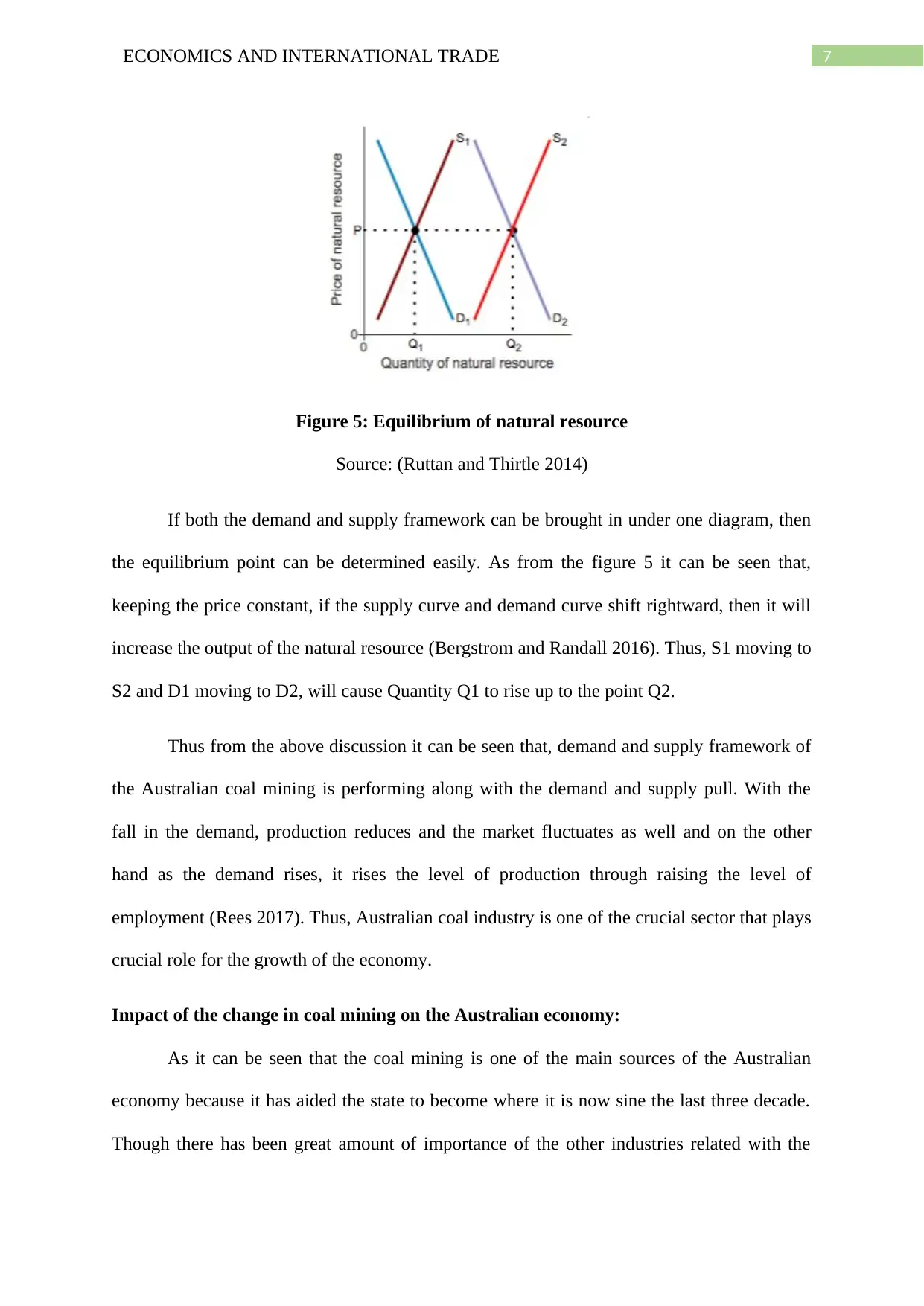
7ECONOMICS AND INTERNATIONAL TRADE
Figure 5: Equilibrium of natural resource
Source: (Ruttan and Thirtle 2014)
If both the demand and supply framework can be brought in under one diagram, then
the equilibrium point can be determined easily. As from the figure 5 it can be seen that,
keeping the price constant, if the supply curve and demand curve shift rightward, then it will
increase the output of the natural resource (Bergstrom and Randall 2016). Thus, S1 moving to
S2 and D1 moving to D2, will cause Quantity Q1 to rise up to the point Q2.
Thus from the above discussion it can be seen that, demand and supply framework of
the Australian coal mining is performing along with the demand and supply pull. With the
fall in the demand, production reduces and the market fluctuates as well and on the other
hand as the demand rises, it rises the level of production through raising the level of
employment (Rees 2017). Thus, Australian coal industry is one of the crucial sector that plays
crucial role for the growth of the economy.
Impact of the change in coal mining on the Australian economy:
As it can be seen that the coal mining is one of the main sources of the Australian
economy because it has aided the state to become where it is now sine the last three decade.
Though there has been great amount of importance of the other industries related with the
Figure 5: Equilibrium of natural resource
Source: (Ruttan and Thirtle 2014)
If both the demand and supply framework can be brought in under one diagram, then
the equilibrium point can be determined easily. As from the figure 5 it can be seen that,
keeping the price constant, if the supply curve and demand curve shift rightward, then it will
increase the output of the natural resource (Bergstrom and Randall 2016). Thus, S1 moving to
S2 and D1 moving to D2, will cause Quantity Q1 to rise up to the point Q2.
Thus from the above discussion it can be seen that, demand and supply framework of
the Australian coal mining is performing along with the demand and supply pull. With the
fall in the demand, production reduces and the market fluctuates as well and on the other
hand as the demand rises, it rises the level of production through raising the level of
employment (Rees 2017). Thus, Australian coal industry is one of the crucial sector that plays
crucial role for the growth of the economy.
Impact of the change in coal mining on the Australian economy:
As it can be seen that the coal mining is one of the main sources of the Australian
economy because it has aided the state to become where it is now sine the last three decade.
Though there has been great amount of importance of the other industries related with the
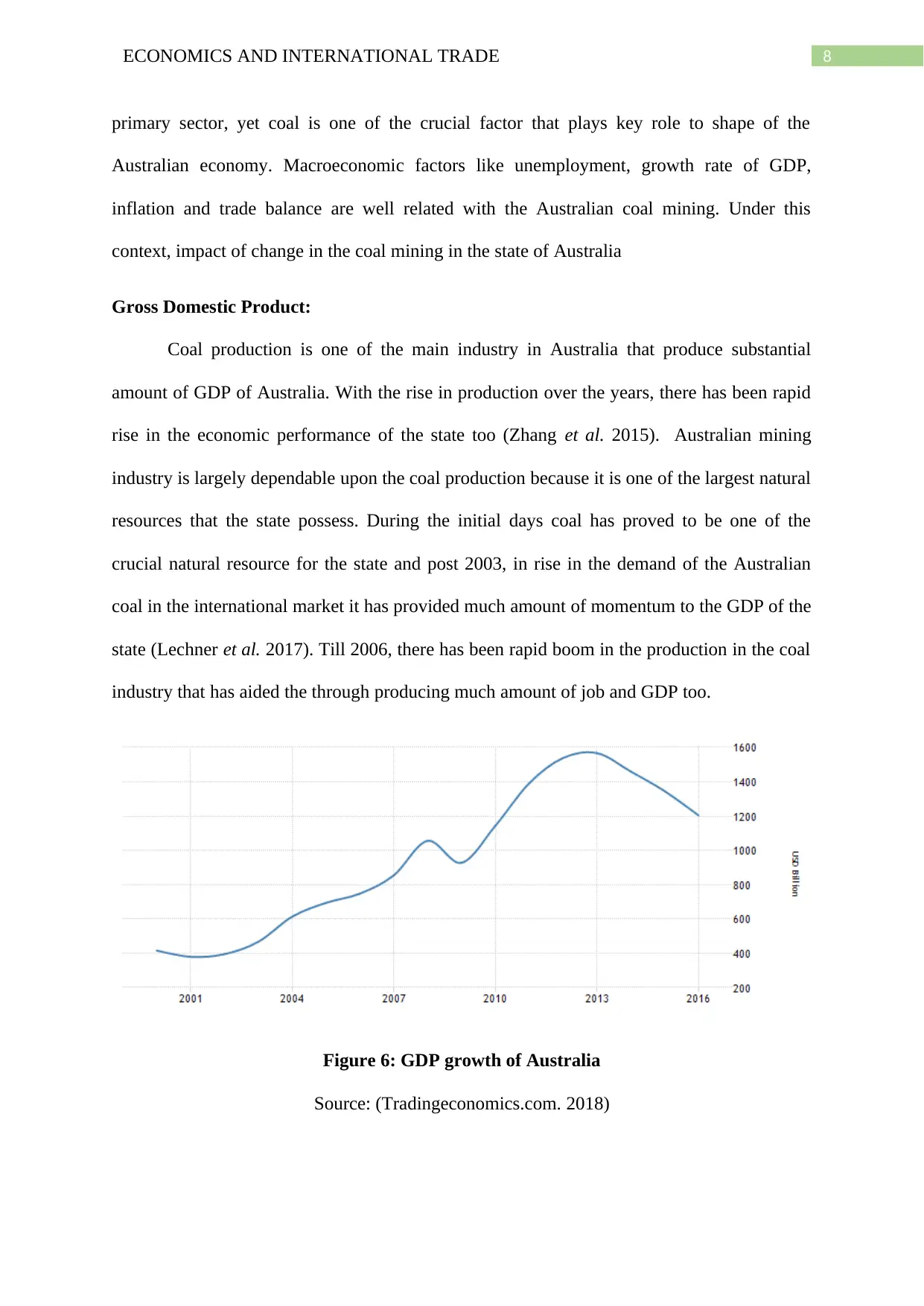
8ECONOMICS AND INTERNATIONAL TRADE
primary sector, yet coal is one of the crucial factor that plays key role to shape of the
Australian economy. Macroeconomic factors like unemployment, growth rate of GDP,
inflation and trade balance are well related with the Australian coal mining. Under this
context, impact of change in the coal mining in the state of Australia
Gross Domestic Product:
Coal production is one of the main industry in Australia that produce substantial
amount of GDP of Australia. With the rise in production over the years, there has been rapid
rise in the economic performance of the state too (Zhang et al. 2015). Australian mining
industry is largely dependable upon the coal production because it is one of the largest natural
resources that the state possess. During the initial days coal has proved to be one of the
crucial natural resource for the state and post 2003, in rise in the demand of the Australian
coal in the international market it has provided much amount of momentum to the GDP of the
state (Lechner et al. 2017). Till 2006, there has been rapid boom in the production in the coal
industry that has aided the through producing much amount of job and GDP too.
Figure 6: GDP growth of Australia
Source: (Tradingeconomics.com. 2018)
primary sector, yet coal is one of the crucial factor that plays key role to shape of the
Australian economy. Macroeconomic factors like unemployment, growth rate of GDP,
inflation and trade balance are well related with the Australian coal mining. Under this
context, impact of change in the coal mining in the state of Australia
Gross Domestic Product:
Coal production is one of the main industry in Australia that produce substantial
amount of GDP of Australia. With the rise in production over the years, there has been rapid
rise in the economic performance of the state too (Zhang et al. 2015). Australian mining
industry is largely dependable upon the coal production because it is one of the largest natural
resources that the state possess. During the initial days coal has proved to be one of the
crucial natural resource for the state and post 2003, in rise in the demand of the Australian
coal in the international market it has provided much amount of momentum to the GDP of the
state (Lechner et al. 2017). Till 2006, there has been rapid boom in the production in the coal
industry that has aided the through producing much amount of job and GDP too.
Figure 6: GDP growth of Australia
Source: (Tradingeconomics.com. 2018)
⊘ This is a preview!⊘
Do you want full access?
Subscribe today to unlock all pages.

Trusted by 1+ million students worldwide
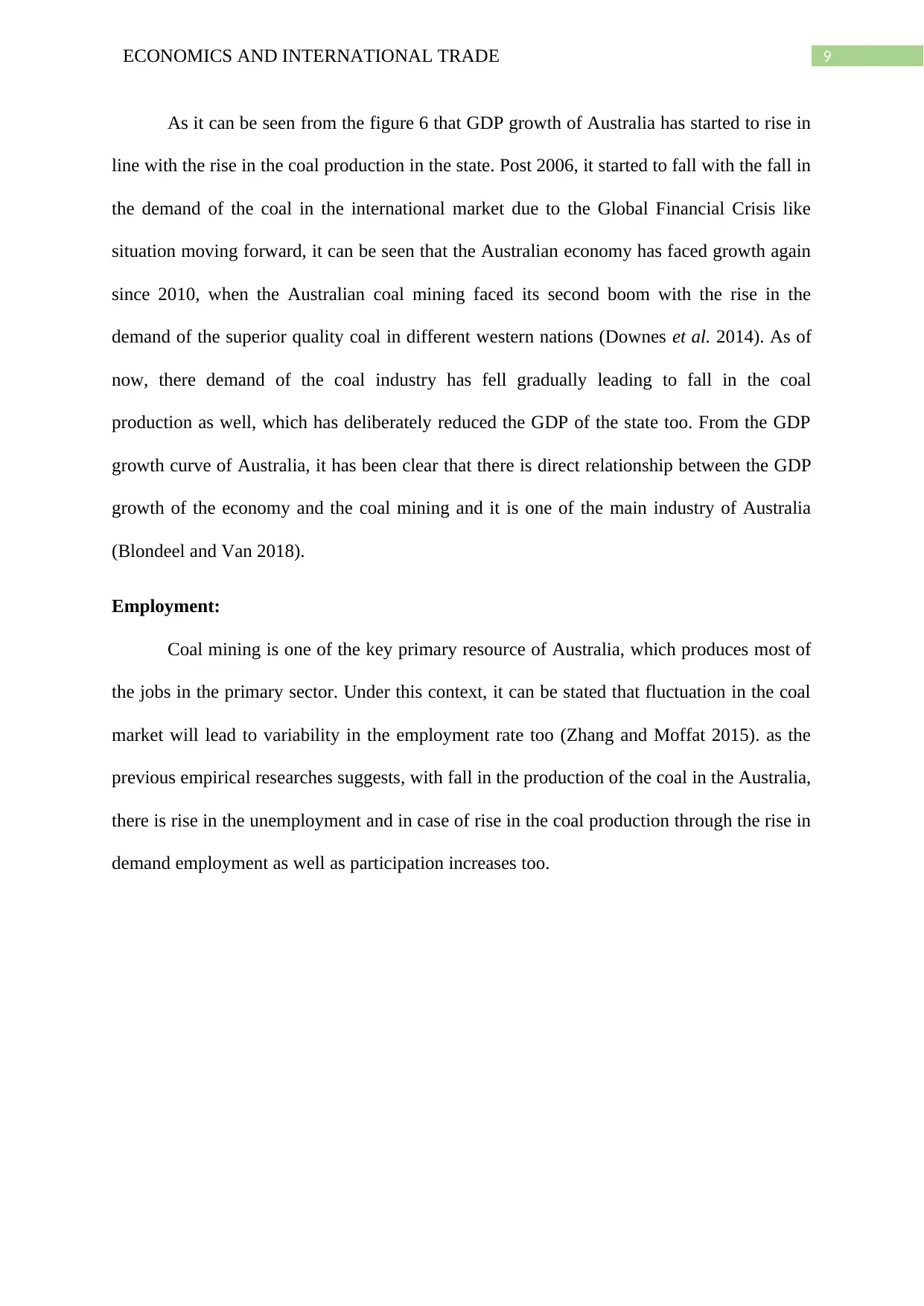
9ECONOMICS AND INTERNATIONAL TRADE
As it can be seen from the figure 6 that GDP growth of Australia has started to rise in
line with the rise in the coal production in the state. Post 2006, it started to fall with the fall in
the demand of the coal in the international market due to the Global Financial Crisis like
situation moving forward, it can be seen that the Australian economy has faced growth again
since 2010, when the Australian coal mining faced its second boom with the rise in the
demand of the superior quality coal in different western nations (Downes et al. 2014). As of
now, there demand of the coal industry has fell gradually leading to fall in the coal
production as well, which has deliberately reduced the GDP of the state too. From the GDP
growth curve of Australia, it has been clear that there is direct relationship between the GDP
growth of the economy and the coal mining and it is one of the main industry of Australia
(Blondeel and Van 2018).
Employment:
Coal mining is one of the key primary resource of Australia, which produces most of
the jobs in the primary sector. Under this context, it can be stated that fluctuation in the coal
market will lead to variability in the employment rate too (Zhang and Moffat 2015). as the
previous empirical researches suggests, with fall in the production of the coal in the Australia,
there is rise in the unemployment and in case of rise in the coal production through the rise in
demand employment as well as participation increases too.
As it can be seen from the figure 6 that GDP growth of Australia has started to rise in
line with the rise in the coal production in the state. Post 2006, it started to fall with the fall in
the demand of the coal in the international market due to the Global Financial Crisis like
situation moving forward, it can be seen that the Australian economy has faced growth again
since 2010, when the Australian coal mining faced its second boom with the rise in the
demand of the superior quality coal in different western nations (Downes et al. 2014). As of
now, there demand of the coal industry has fell gradually leading to fall in the coal
production as well, which has deliberately reduced the GDP of the state too. From the GDP
growth curve of Australia, it has been clear that there is direct relationship between the GDP
growth of the economy and the coal mining and it is one of the main industry of Australia
(Blondeel and Van 2018).
Employment:
Coal mining is one of the key primary resource of Australia, which produces most of
the jobs in the primary sector. Under this context, it can be stated that fluctuation in the coal
market will lead to variability in the employment rate too (Zhang and Moffat 2015). as the
previous empirical researches suggests, with fall in the production of the coal in the Australia,
there is rise in the unemployment and in case of rise in the coal production through the rise in
demand employment as well as participation increases too.
Paraphrase This Document
Need a fresh take? Get an instant paraphrase of this document with our AI Paraphraser
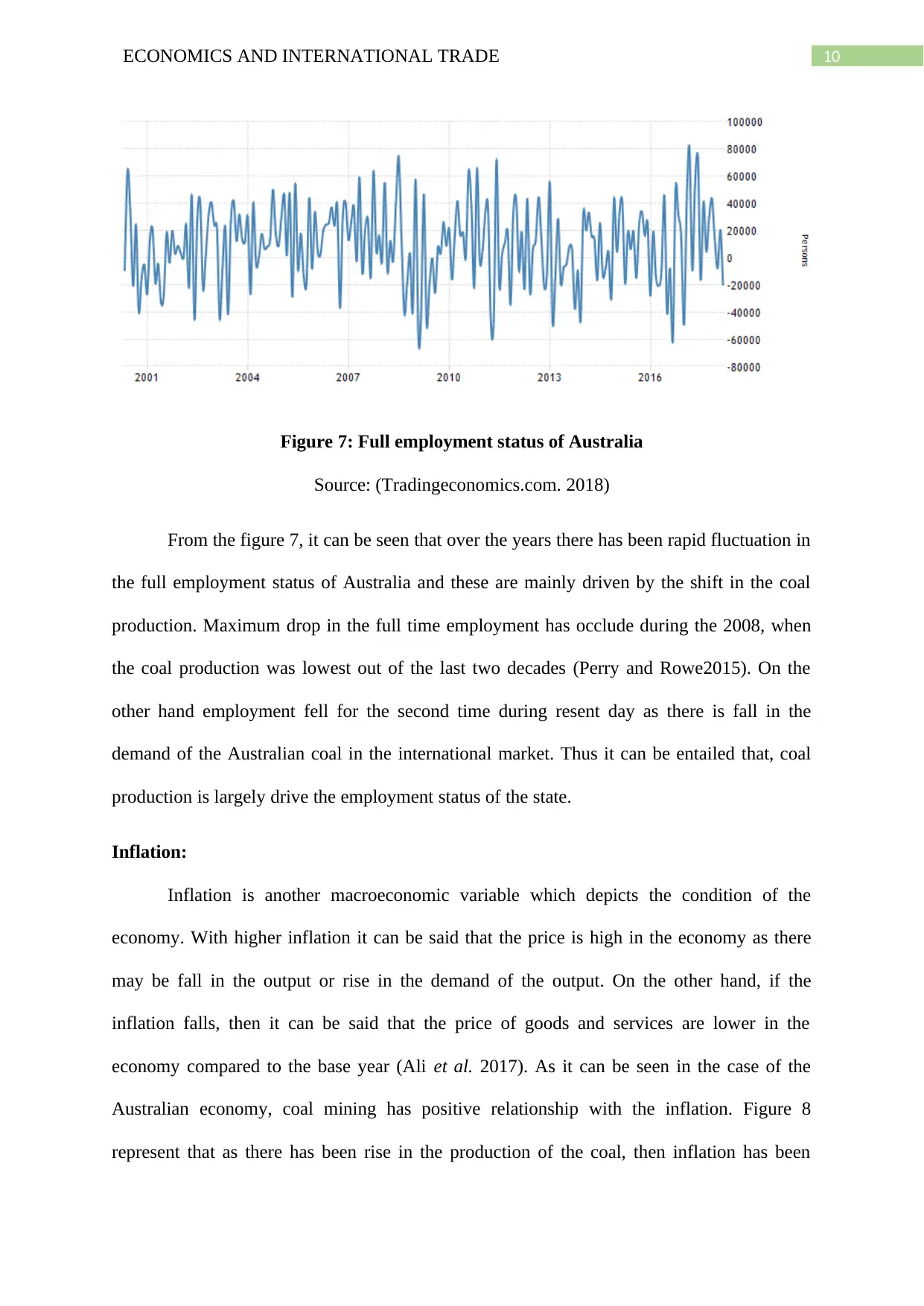
10ECONOMICS AND INTERNATIONAL TRADE
Figure 7: Full employment status of Australia
Source: (Tradingeconomics.com. 2018)
From the figure 7, it can be seen that over the years there has been rapid fluctuation in
the full employment status of Australia and these are mainly driven by the shift in the coal
production. Maximum drop in the full time employment has occlude during the 2008, when
the coal production was lowest out of the last two decades (Perry and Rowe2015). On the
other hand employment fell for the second time during resent day as there is fall in the
demand of the Australian coal in the international market. Thus it can be entailed that, coal
production is largely drive the employment status of the state.
Inflation:
Inflation is another macroeconomic variable which depicts the condition of the
economy. With higher inflation it can be said that the price is high in the economy as there
may be fall in the output or rise in the demand of the output. On the other hand, if the
inflation falls, then it can be said that the price of goods and services are lower in the
economy compared to the base year (Ali et al. 2017). As it can be seen in the case of the
Australian economy, coal mining has positive relationship with the inflation. Figure 8
represent that as there has been rise in the production of the coal, then inflation has been
Figure 7: Full employment status of Australia
Source: (Tradingeconomics.com. 2018)
From the figure 7, it can be seen that over the years there has been rapid fluctuation in
the full employment status of Australia and these are mainly driven by the shift in the coal
production. Maximum drop in the full time employment has occlude during the 2008, when
the coal production was lowest out of the last two decades (Perry and Rowe2015). On the
other hand employment fell for the second time during resent day as there is fall in the
demand of the Australian coal in the international market. Thus it can be entailed that, coal
production is largely drive the employment status of the state.
Inflation:
Inflation is another macroeconomic variable which depicts the condition of the
economy. With higher inflation it can be said that the price is high in the economy as there
may be fall in the output or rise in the demand of the output. On the other hand, if the
inflation falls, then it can be said that the price of goods and services are lower in the
economy compared to the base year (Ali et al. 2017). As it can be seen in the case of the
Australian economy, coal mining has positive relationship with the inflation. Figure 8
represent that as there has been rise in the production of the coal, then inflation has been
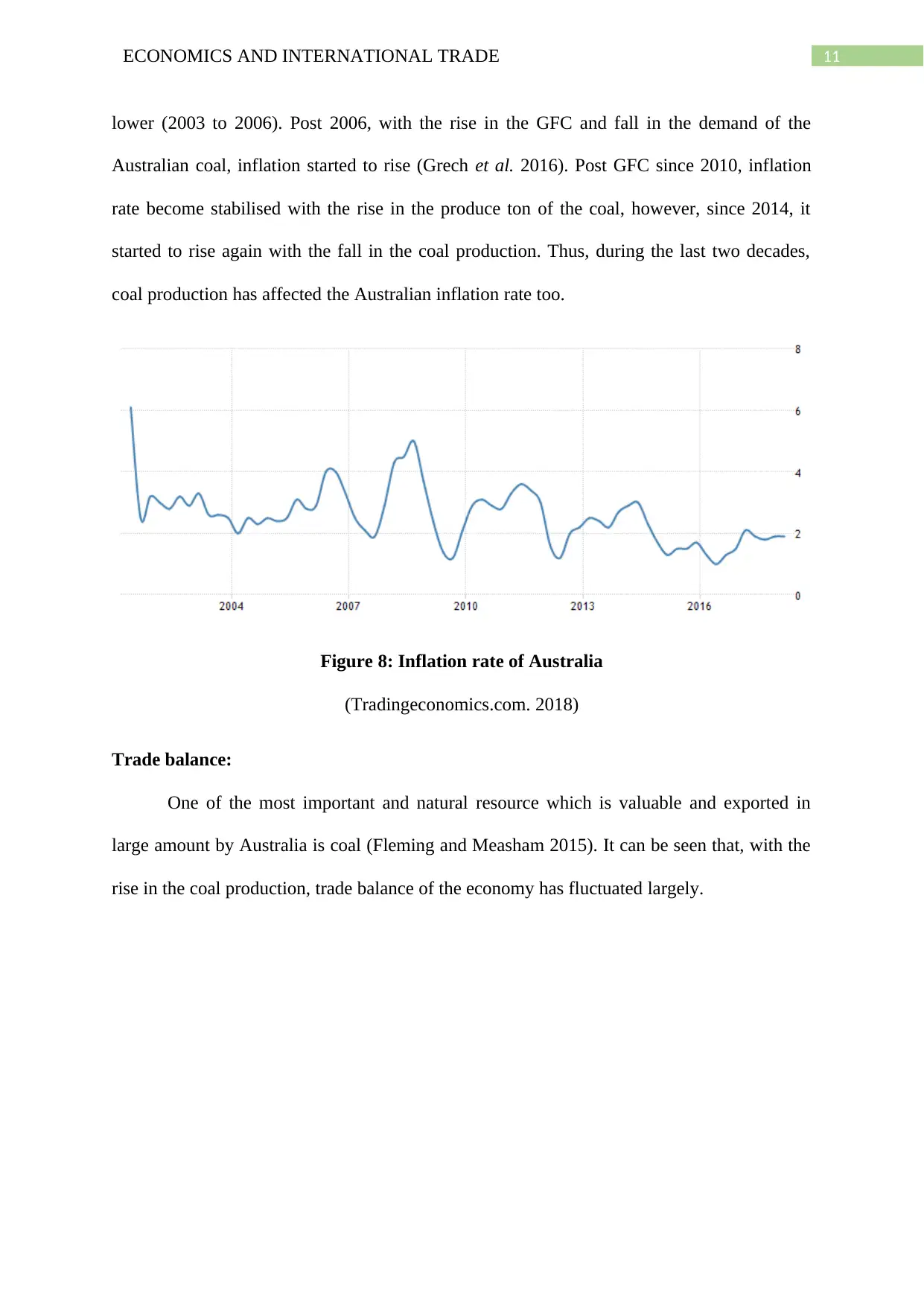
11ECONOMICS AND INTERNATIONAL TRADE
lower (2003 to 2006). Post 2006, with the rise in the GFC and fall in the demand of the
Australian coal, inflation started to rise (Grech et al. 2016). Post GFC since 2010, inflation
rate become stabilised with the rise in the produce ton of the coal, however, since 2014, it
started to rise again with the fall in the coal production. Thus, during the last two decades,
coal production has affected the Australian inflation rate too.
Figure 8: Inflation rate of Australia
(Tradingeconomics.com. 2018)
Trade balance:
One of the most important and natural resource which is valuable and exported in
large amount by Australia is coal (Fleming and Measham 2015). It can be seen that, with the
rise in the coal production, trade balance of the economy has fluctuated largely.
lower (2003 to 2006). Post 2006, with the rise in the GFC and fall in the demand of the
Australian coal, inflation started to rise (Grech et al. 2016). Post GFC since 2010, inflation
rate become stabilised with the rise in the produce ton of the coal, however, since 2014, it
started to rise again with the fall in the coal production. Thus, during the last two decades,
coal production has affected the Australian inflation rate too.
Figure 8: Inflation rate of Australia
(Tradingeconomics.com. 2018)
Trade balance:
One of the most important and natural resource which is valuable and exported in
large amount by Australia is coal (Fleming and Measham 2015). It can be seen that, with the
rise in the coal production, trade balance of the economy has fluctuated largely.
⊘ This is a preview!⊘
Do you want full access?
Subscribe today to unlock all pages.

Trusted by 1+ million students worldwide
1 out of 17
Related Documents
Your All-in-One AI-Powered Toolkit for Academic Success.
+13062052269
info@desklib.com
Available 24*7 on WhatsApp / Email
![[object Object]](/_next/static/media/star-bottom.7253800d.svg)
Unlock your academic potential
Copyright © 2020–2026 A2Z Services. All Rights Reserved. Developed and managed by ZUCOL.





